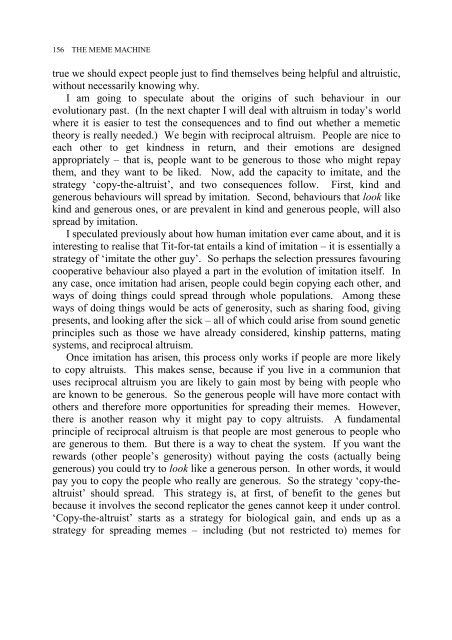The Meme Machine
TheMemeMachine1999
TheMemeMachine1999
- No tags were found...
You also want an ePaper? Increase the reach of your titles
YUMPU automatically turns print PDFs into web optimized ePapers that Google loves.
156 THE MEME MACHINE<br />
true we should expect people just to find themselves being helpful and altruistic,<br />
without necessarily knowing why.<br />
I am going to speculate about the origins of such behaviour in our<br />
evolutionary past. (In the next chapter I will deal with altruism in today’s world<br />
where it is easier to test the consequences and to find out whether a memetic<br />
theory is really needed.) We begin with reciprocal altruism. People are nice to<br />
each other to get kindness in return, and their emotions are designed<br />
appropriately – that is, people want to be generous to those who might repay<br />
them, and they want to be liked. Now, add the capacity to imitate, and the<br />
strategy ‘copy-the-altruist’, and two consequences follow. First, kind and<br />
generous behaviours will spread by imitation. Second, behaviours that look like<br />
kind and generous ones, or are prevalent in kind and generous people, will also<br />
spread by imitation.<br />
I speculated previously about how human imitation ever came about, and it is<br />
interesting to realise that Tit-for-tat entails a kind of imitation – it is essentially a<br />
strategy of ‘imitate the other guy’. So perhaps the selection pressures favouring<br />
cooperative behaviour also played a part in the evolution of imitation itself. In<br />
any case, once imitation had arisen, people could begin copying each other, and<br />
ways of doing things could spread through whole populations. Among these<br />
ways of doing things would be acts of generosity, such as sharing food, giving<br />
presents, and looking after the sick – all of which could arise from sound genetic<br />
principles such as those we have already considered, kinship patterns, mating<br />
systems, and reciprocal altruism.<br />
Once imitation has arisen, this process only works if people are more likely<br />
to copy altruists. This makes sense, because if you live in a communion that<br />
uses reciprocal altruism you are likely to gain most by being with people who<br />
are known to be generous. So the generous people will have more contact with<br />
others and therefore more opportunities for spreading their memes. However,<br />
there is another reason why it might pay to copy altruists. A fundamental<br />
principle of reciprocal altruism is that people are most generous to people who<br />
are generous to them. But there is a way to cheat the system. If you want the<br />
rewards (other people’s generosity) without paying the costs (actually being<br />
generous) you could try to look like a generous person. In other words, it would<br />
pay you to copy the people who really are generous. So the strategy ‘copy-thealtruist’<br />
should spread. This strategy is, at first, of benefit to the genes but<br />
because it involves the second replicator the genes cannot keep it under control.<br />
‘Copy-the-altruist’ starts as a strategy for biological gain, and ends up as a<br />
strategy for spreading memes – including (but not restricted to) memes for



